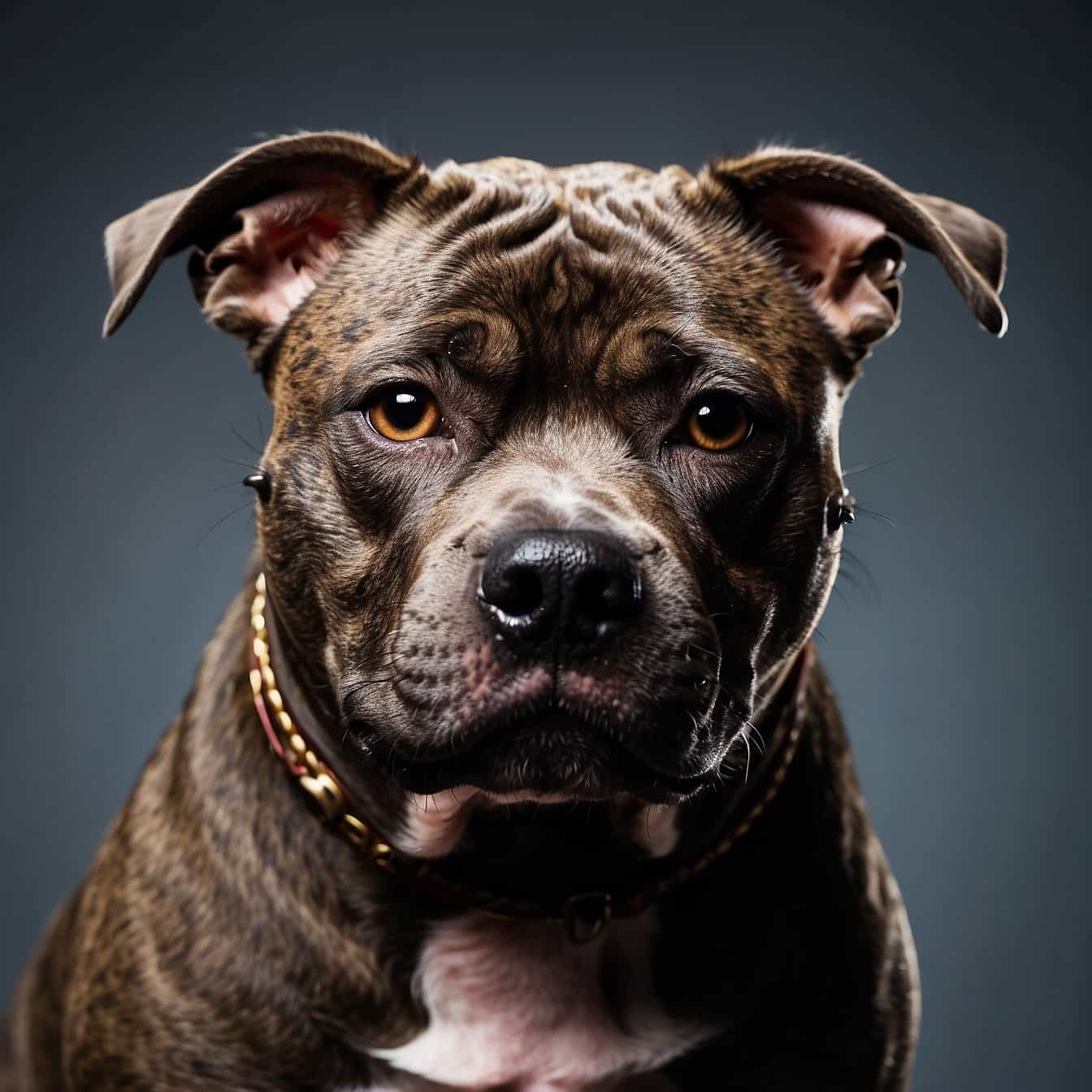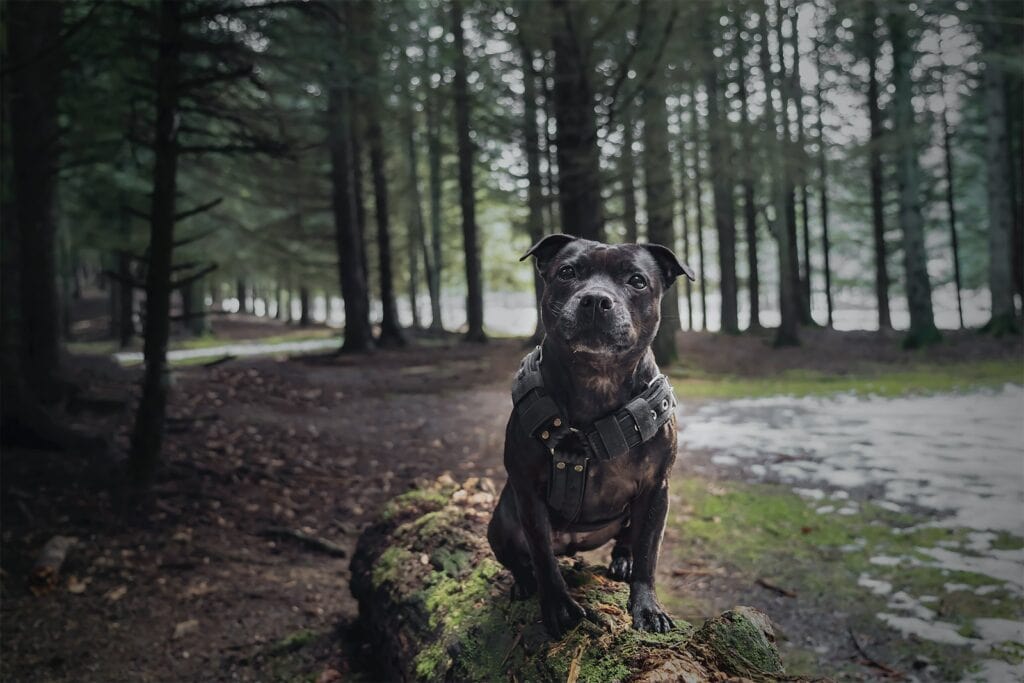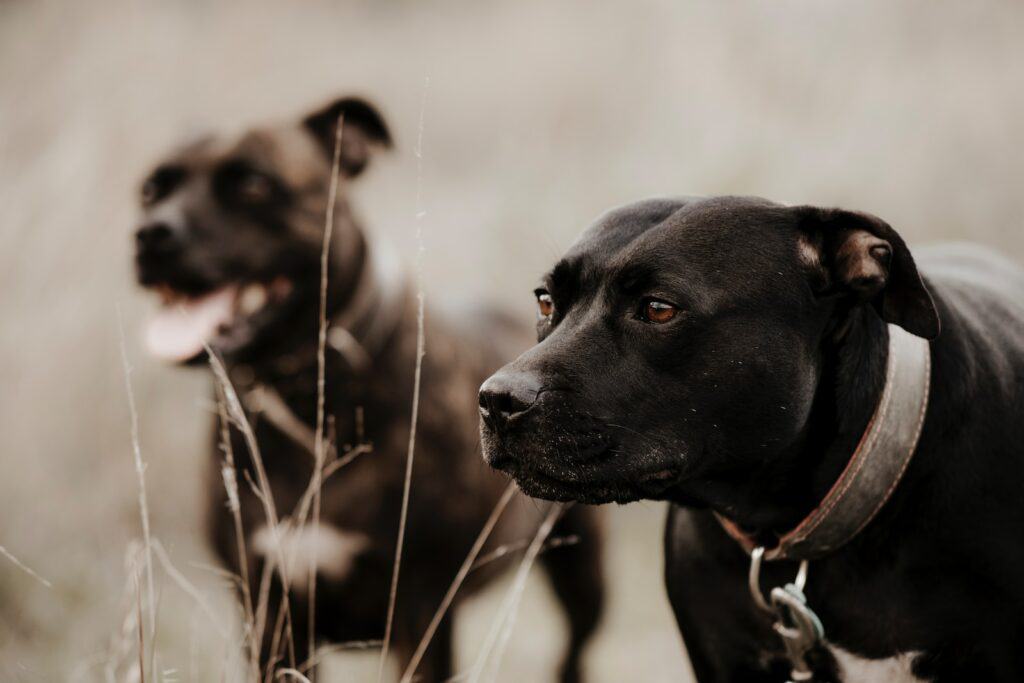Staffordshire Bull Terriers, or Staffies, are known for their affectionate nature and muscular build. Uncover their history, explore the care they need to thrive, and appreciate the loving and protective traits that make them cherished family pets.

| Category (Explanation) | Breed Information |
|---|---|
| Year of Breed Conception | 1800s |
| Country of Origin | United Kingdom |
| Weight (lbs & kg) (Male) | 28-38 lbs (13-17 kg) |
| Weight (lbs & kg) (Female) | 24-34 lbs (11-15.5 kg) |
| Coat Type | Smooth and short |
| Color Variations | Red, fawn, white, black, blue, or brindle |
| Shedding Level (Low, Moderate, High) | Low to Moderate |
| Height (cm & in) | 14-16 inches (36-41 cm) |
| Breed Size | Medium |
| Trainability (Low, Moderate, High) | Moderate |
| Mental Needs (Low, Moderate, High) | Moderate |
| Intelligence Level (Low, Moderate, High) | Moderate |
| Energy Level (Low, Moderate, High) | Moderate to High |
| Agility (Low, Moderate, High) | High |
| Loyalty (Low, Moderate, High) | High |
| Playfulness (Low, Moderate, High) | High |
| Exercise Needs | Regular exercise and playtime |
| Guarding Proficiency (Low, Moderate, High) | High |
| Sociability with Children (Low, Moderate, High) | High |
| Barking Level (Low, Moderate, High) | Moderate |
| Digging Tendency (Low, Moderate, High) | Moderate |
| Destructive Behavior (Low, Moderate, High) | Moderate |
| Drooling Level (Low, Moderate, High) | Low |
| Obedience Level (Low, Moderate, High) | Moderate |
| Apartment Friendly (Yes/No) | Yes, with sufficient exercise |
| Inherent Prey Drive | Moderate |
| Physical Risk to Others (Low, Moderate, High) | Low |
| Travel Fatality Risk (Low, Moderate, High) | Low |
| Allergen Potential | Low |
| Health Concerns (List of Common Health Concerns) | Hip Dysplasia, Cataracts, L-2-HGA |
| Average Life Expectancy (Life Expectancy in Years) | 12-16 years |
Woof Mastery is reader supported and our articles may contain affiliate links.
Instead of running third party ads that we have no control of we only use links from high-quality companies we are directly partnered with. Making use of these links come at no cost to you our reader, and in many cases have the extra benefit of discounted rates or sign up bonuses.
If you’re interested you can read more about our affiliate policy here.
We appreciate your support and always insure that the products and services we recommend are high-quality, helpful and relevant to the subject at hand!
Staffordshire Bull Terriers, or Staffies, have a history that goes back to the early 19th century in England. Bred for their affectionate nature and muscular build, they were known as “nanny dogs” for their protective and loving qualities. Staffies transitioned from their early role as working dogs to cherished family pets. Their loyalty and protective instincts have made them popular choices for those seeking an affectionate and watchful companion. Today, Staffordshire Bull Terriers continue to be beloved members of countless families, known for their affectionate and protective nature.

Staffordshire Bull Terriers, or Staffies, are special for their affectionate nature and muscular build. Uncover their history, explore the care they need to thrive, and appreciate the loving and protective traits that make them cherished family pets. What sets them apart is their unique combination of affection and strength, making them special companions and loyal protectors for their families.
Staffordshire Bull Terriers, often known as Staffies, have a traditional role deeply tied to their affectionate nature and muscular build. Originally bred in England, their primary role was as companions and protectors of families. Their strength and loyalty made them excellent as guardians of homes. They were also known for their ability to work in coal mines, and their tenacity earned them a reputation as reliable working dogs. Today, Staffies are cherished family pets, but their historical role as protectors and affectionate companions continues to be an integral part of their identity.
Staffordshire Bull Terriers, or Staffies, have affectionate and protective personalities. They are known for their muscular build and loyalty. These terriers can be loving and make great family pets. They are protective of their families and require training and socialization to ensure they are well-behaved and affectionate companions.
Staffordshire Bull Terriers, or Staffies, are known for their affectionate and muscular build. They are typically protective of their families and can be loving and loyal companions. However, they may exhibit territorial behavior and can be stubborn at times, requiring consistent and patient training. Their strength and size can pose challenges if not adequately controlled, making leash training crucial. Additionally, they may not always get along with other dogs, particularly of the same sex, necessitating careful introductions.
Staffordshire Bull Terriers, or Staffies, have a muscular and stocky build. They have a short, smooth, and dense coat that comes in various colors. Their head is broad, and they have a strong, square-shaped jaw. Staffies have expressive dark eyes and a short tail. Their legs are sturdy and strong. They have an affectionate and confident gait, reflecting their loving and protective traits.
Staffordshire Bull Terriers often have a smooth, short coat that comes in various colors. Common coat colors for Staffies include red, fawn, brindle, black, or blue. They may have white markings or patches on their bodies. The variation in coat colors enhances their affectionate and muscular appearance.
Staffordshire Bull Terriers have a low shedding level. These muscular and short-coated dogs shed minimally throughout the year. Regular brushing with a soft-bristle brush or grooming mitt can help remove loose hair and keep their coat in good condition. While shedding is not a major concern with this breed, other aspects of care, such as dental hygiene, regular exercise, and a balanced diet, contribute to their overall well-being. Proper grooming practices, including regular checks for any skin issues or abnormalities, are essential for maintaining the health of their coat.
Staffordshire Bull Terriers have short coats that are easy to maintain.
Brushing: Regular brushing, about once or twice a week, helps remove loose hair and keeps their coat healthy. A soft bristle brush or grooming mitt is suitable for their coat type.
Bathing: Bathe as needed, typically when they get dirty. Use a mild dog shampoo to maintain a healthy coat. Be sure to rinse thoroughly and dry completely after bathing.
Ears: Check and clean their ears regularly to prevent wax buildup or infections. Use a damp cotton ball or a veterinarian-recommended ear cleaning solution.
Nails: Keep their nails trimmed regularly to prevent discomfort or issues with their gait.
Teeth: Brush their teeth regularly to promote good oral hygiene. Dental chews or toys can also be beneficial.
Staffordshire Bull Terriers have a moderate to high activity level. As strong and athletic dogs, they benefit from regular exercise, including walks, playtime, and interactive activities. Providing mental stimulation through training sessions and puzzle toys is important to keep them engaged. Staffordshire Bull Terriers enjoy spending time with their owners and can excel in various dog sports and activities.
Staffordshire Bull Terriers are known for their intelligence, marked by problem-solving abilities, agility, and a desire to please their owners. They are generally trainable and responsive to positive reinforcement training methods. Staffordshire Bull Terriers can learn various commands and tasks. Their agility allows them to excel in roles such as hunting and agility sports. Historically, they were skilled in roles such as hunting and guarding, showcasing social intelligence by forming strong bonds with their families. While they may not top the charts in terms of obedience, their intelligence makes them excellent companions and working dogs. Training, socialization, and mental stimulation contribute to their well-rounded and obedient nature.
Staffordshire Bull Terriers thrive on mental stimulation. Engage them in activities like puzzle toys, interactive games, and obedience training to keep their minds sharp and prevent boredom.
Social Interaction: They are social dogs and need regular interaction with their family. Loneliness can lead to anxiety, so provide companionship and attention.
Exercise: Regular physical activity is crucial for their mental and physical well-being. Daily walks and playtime help reduce stress and prevent behavioral issues.
Enter The Woof Mastery

Prospective owners of Staffordshire Bull Terriers should be prepared for a strong and affectionate companion. Regular exercise and mental stimulation contribute to their well-being. Grooming their short coat is low-maintenance. Staffordshire Bull Terriers are known for their intelligence, so early training and socialization are crucial. Potential owners should be aware of breed-specific laws in their area. Responsible ownership includes providing ample love, attention, and a safe environment to ensure the well-being of these loyal and energetic companions.
Staffordshire Bull Terriers, known for their affectionate nature, generally pose a low risk to others. Proper socialization and training contribute to positive interactions. Responsible ownership, understanding individual temperament, and adherence to local regulations play crucial roles in ensuring a well-behaved Staffordshire Bull Terrier.
Staffordshire Bull Terriers are often good with children. They are known for their affectionate nature. Supervision is important during play, and positive reinforcement training helps ensure positive interactions. Teaching children how to approach and handle the dog contributes to a positive relationship.
Staffordshire Bull Terriers are generally good swimmers. Their muscular build and love for activity may make them enjoy water. Introduce them to water gradually and observe their comfort level. Always prioritize safety and use a canine life vest if needed, especially in situations where they may be at risk of fatigue.
Training your Staffordshire Bull Terrier puppy is a rewarding journey that strengthens your bond and sets the foundation for a well-behaved adult dog. Enjoy the process and celebrate each milestone!
Staffordshire Bull Terriers are not typically considered noisy dogs. While they may bark on occasion, excessive barking is not a common trait. Proper training, socialization, and providing mental and physical stimulation contribute to a well-behaved Staffordshire Bull Terrier.
Staffordshire Bull Terriers are adaptable and thrive in homes with active owners. They do well in both houses with yards and apartments, provided they receive sufficient exercise and mental stimulation. Regular playtime and socialization contribute to their well-being. Positive reinforcement training is effective in shaping their behavior.
When traveling with Staffordshire Bull Terriers, prioritize their safety and well-being:
Addressing these considerations helps ensure safe and comfortable travel for Staffordshire Bull Terriers.
Staffordshire Bull Terriers may be prone to specific health concerns. While not all individuals will experience these issues, it’s important for Staffordshire Bull Terrier owners to be aware of potential health problems and collaborate with veterinarians for their pets’ well-being. Common health concerns in Staffordshire Bull Terriers include:
Regular veterinary check-ups, a balanced diet, proper exercise, and responsible breeding practices can help mitigate some of these health concerns in Staffordshire Bull Terriers.
Proper nutrition is crucial for the health and well-being of Staffordshire Bull Terriers. Here are some nutritional habits and best practices to consider for this breed:
Breed-Specific Laws (BSL): Staffordshire Bull Terriers may be subject to breed-specific laws (BSL) in certain areas. These laws are often enacted at the local or municipal level and can vary widely from one jurisdiction to another.
Types of Restrictions: The specific restrictions imposed on Staffordshire Bull Terriers under BSL can include mandatory spaying/neutering, special licensing, liability insurance requirements, muzzling in public, and, in some cases, bans on ownership. The severity of these restrictions depends on local regulations.
Rationale for BSL: BSL is typically implemented based on concerns about public safety and perceived risks associated with specific breeds, often due to incidents involving dog attacks. While Staffordshire Bull Terriers are not inherently aggressive, they can be affected by BSL due to their physical resemblance to breeds that are sometimes included in these laws.
Controversy: It’s important to note that BSL is a controversial topic. Critics argue that it unfairly targets breeds rather than addressing individual dog behavior and that responsible ownership and training should be emphasized instead of breed-specific restrictions.
Local Regulations: To determine if there are breed-specific laws or restrictions regarding Staffordshire Bull Terriers in your area, you should check with your local animal control or government authorities. Be aware of and comply with any local regulations to ensure that you are in compliance with the law while owning a Staffordshire Bull Terrier.
Woof Mastery is reader supported and our articles may contain affiliate links.
Instead of running third party ads that we have no control of we only use links from high-quality companies we are directly partnered with. Making use of these links come at no cost to you our reader, and in many cases have the extra benefit of discounted rates or sign up bonuses.
If you’re interested you can read more about our affiliate policy here.
We appreciate your support and always insure that the products and services we recommend are high-quality, helpful and relevant to the subject at hand!
Myth 1: Staffordshire Bull Terriers are Naturally Aggressive
Myth 2: They are the Same as Pit Bulls
Myth 3: They are Not Good with Children
Myth 4: They Have Locking Jaws
Myth 5: They are Not Intelligent
Myth 6: They Need Aggressive Training
Myth 7: They are Only Suitable for Experienced Owners
Myth 8: They Don’t Get Along with Other Dogs
Myth 9: They are Too Energetic for Apartment Living
Myth 10: They Cannot Be Trusted Around People
Dispelling these myths is essential to promoting a better understanding of Staffordshire Bull Terriers and ensuring they are judged based on their individual behavior and temperament.
Famous Staffordshire Bull Terrier owners include:
Petey: Petey, the dog with the distinctive eye patch from the television series “The Little Rascals,” was a Staffordshire Bull Terrier.
The Staffordshire Bull Terrier is culturally significant as a breed with a loyal and affectionate nature. Historically used in blood sports, Staffies have undergone a transformation to become beloved family pets. They are recognized for their courage and friendly temperament, and efforts by advocates have helped dispel misconceptions about the breed. Staffordshire Bull Terriers have become symbols of resilience and the potential for positive change in perceptions of certain dog breeds.
The Staffordshire Bull Terrier, known for its muscular build and friendly nature, does not have a widely recognized historical owner. However, Staffordshire Bull Terriers have gained popularity as loyal companions and family pets.
Staffordshire Bull Terriers, known for their strength and affectionate nature, face challenges that include:
The Staffordshire Bull Terrier, known for its muscular build and friendly nature, is believed to have been developed through a combination of terrier and bulldog breeds. The contributing breeds include:
Staffordshire Bull Terriers, with their muscular build and friendly disposition, make wonderful family companions. Known for their loyalty and adaptability, they integrate well into family life. Their moderate size and distinctive appearance make them suitable for various living conditions. Staffordshire Bull Terriers excel in activities and training, showcasing their agility and enthusiasm. Their affectionate nature and compatibility with children make them valued additions to households seeking a playful and devoted companion.